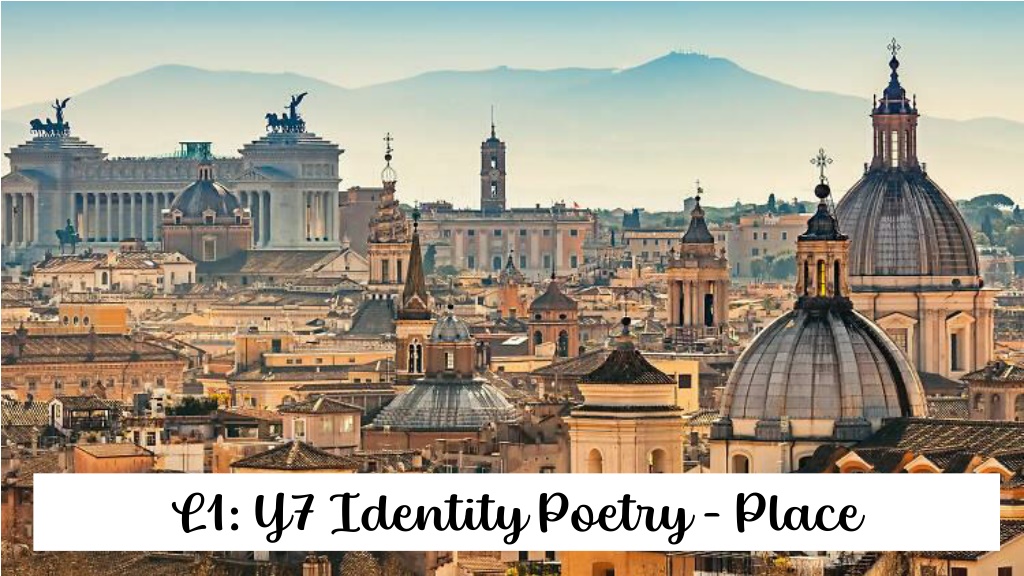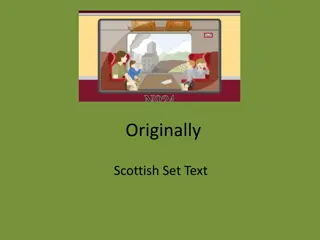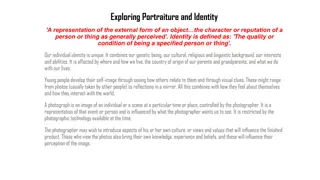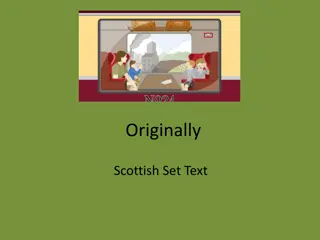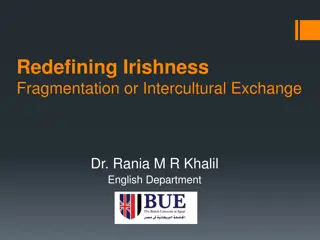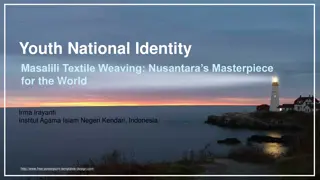Exploring the Impact of Place on Identity
In this unit, students delve into the profound influence of place on personal identity. The lesson prompts reflection on the significance of places that have shaped individuals' lives, sparking introspection on the connections between place and identity. Through discussions and personal reflections, learners explore how diverse locations, from birthplaces to travel destinations, mold their sense of self.
Download Presentation

Please find below an Image/Link to download the presentation.
The content on the website is provided AS IS for your information and personal use only. It may not be sold, licensed, or shared on other websites without obtaining consent from the author. Download presentation by click this link. If you encounter any issues during the download, it is possible that the publisher has removed the file from their server.
E N D
Presentation Transcript
Date: 27th April 2022 Title: To what extent does place impact upon our own sense of identity? Recap questions: 1. What is a collective noun? 2.What is a comparative adjective? 3.What is an inference? 4.What is a simile? 5.What is an autobiography? Do it now Miss Odell is currently reading
This year all of the topics we have studied have linked to the theme of Emerging Identities . Let s review our learning from this year, with this theme in mind. You have been given a roadmap to help with this reflection. I want you to consider the following: What have you learnt about Emerging Identities when we completed our mythology unit? What did you learn about Emerging Identities when we read The Terrible Thing that Happened to Barnaby Brocket? What did you learn about Emerging Identities when we read, and you crafted, memoir extracts? Do it now Try filling in as much detail on the road map as possible by yourself before sharing your ideas with your talk partner.
In this unit, we are going to explore the impact that place has on our identity. The key question we are going to be asking ourselves is To what extent does place impact our own sense of identity? New knowledge Before we begin this unit, I want you to have a think: To what extent do you think place impacts our own sense of identity?
For many of us, place plays a significant role in our lives. This could be because we were born somewhere entirely different to where we are now. It could be because we have parents who come from different countries. But it could also be because we have travelled somewhere that has become significant to us. In today s lesson, we shall consider the impact that places have on us, who we are, as people. For me, there are two places that have had a significant impact on me: England and Italy. New knowledge
Now its your turn. Using your glasses consider the place or places that have impacted you in your life or are significant to you. Pen to paper
Lets now share our glasses with each other and explain the impact that particular places might have had on us already in our short lives. Reflection As you are listening to each other speak, what do you notice about HOW place has impacted someone s life?
Date: 27th April 2022 Title: How does Fleur Adcock express her feelings about Stewart Island? Recap questions: 1. What is a compound noun? 2. What is a superlative adjective? 3. What does the phrase implied meaning when talking about a writer s work? 4. What s a metaphor? 5. What is a biography? Do it now Miss Odell is currently reading
In todays lesson we are going to learn about a place called Stewart Island from the perspective of the poet, Fleur Adcock. Stewart Island is set just south of New Zealand. Here are some pictures of Stewart Island: New Knowledge
We are going to use these pictures to consider your initial impression of place. Nouns to describe Stewart Island Adjectives to describe Stewart Island Pen to paper My initial impression of Stewart Island is
However, we are going to learn whether our impression of Stewart Island is the same as the impression the poet, Fleur Adcock, has. Let s read her poem Stewart Island , which was written in 1971. This poem is written using one long stanza and free verse, which means there is no rhyme. Stewart Island by Fleur Adcock (1971) But look at all this beauty Said the hotel manager s wife When asked how she could bear to Live there. True: there was a fine bay, All hills and atmosphere; white Sand, and bush down to the sea s edge; Oyster-boats, too, and Maori Fishermen with Scottish names (she Ran off with one that autumn). As for me, I walked on the beach; It was too cold to swim. My Seven-year-old collected shells And was bitten by sandflies; My four-year-old paddled, until A mad seagull jetted down To jab its claws and beak into His head. I had already decided to leave this country. New knowledge Key question: How does Fleur Adcock view Stewart Island?
As you read a poem, or any text for that matter, we want to identify the BIG IDEAS of the poem. These are called the central concerns. They are central concerns because they are the BIG IDEAS the writer is potentially wishing to communicate to their readers. (When writing about texts, the central concern is the WHAT of our analytical paragraph). Here is what I think is the first central concern of this poem. New knowledge Central concern Fleur Adcock recognises the beauty of Stewart Island.
But our key question today is about HOW she expresses her feelings. I think her recognition of Stewart Island s beauty is done through the language choices she makes, in this instance, her use of nouns and noun phrases. I have identified the first one but how many other nouns or noun phrases can you find that show she recognises Stewart Island s beauty. fine bay Pen to paper Nouns and noun phrases used to describe Stewart Island Key question: having pulled out the nouns and noun phrases, from the text, what impression do you think she has formed of Stewart Island? What does she recognise about the island?
Whilst Fleur Adcock recognises the beauty of Stewart Island, we see a volta appear. This is a structural device. Look at the following bits of evidence. As for me, I walked on the beach; New knowledge It was too cold to swim. My Seven-year-old collected shells And was bitten by sandflies; My four-year-old paddled, until A mad seagull jetted down To jab its claws and beak into His head. Key question: What might the central concern be in the second part of the poem?
But our key question today is about HOW she expresses her feelings. I think she does this through the use of contrasts. This is a structural device. First part How is the contrast introduced? Second part Inference linked to Fleur Adcock s feelings As for me, I walked on the beach; It was too cold to swim. Pen to Paper My seven-year-old collected shells And was bitten by sandflies. My four-year-old paddled, Until / A mad seagull jetted down / To jab its claws and beak into his head.
The key question for this Learning Episode was How does Fleur Adcock express her feelings about Stewart Island? We have discovered that she uses nouns and noun phrases to illustrate how she recognises the island s beauty and how she uses contrasts to imply she is at conflict with the reality of being on the island. Reflection This term, for your assessment, you will need to respond to one poem from the studied anthology to consider how place has an impact on one s sense of identity. You will need to construct a response using two WHAT HOW WHY paragraphs. What might an EXCELLING WHAT HOW WHY paragraph look like in response to this poem?
RO1: Reading for understanding selecting and interpreting information, ideas and perspectives Excelling I can confidently infer meaning from a text. I can explain a writer s intention and viewpoint. I can draw upon well-chosen references to the text to support my ideas and explain these. In the poem, Stewart Island, Fleur Adcock initially recognises the beauty of the island when she acknowledges its fine bay , white sand and the Maori fishermen . The use of the noun phrases here implying a beautiful, natural and peaceful environment. The use of the adjective fine to describe the bay suggests that it is indeed beautiful and aesthetically pleasing. This is reinforced by the adjective white to describe the sand and helps the reader to imagine the clean, vibrant beach side. Finally, the description of the Maori fishermen gives an image of an area steeped in tradition with men going out to fish to supply the island with its food and connotes this idea of peace and serenity. Reflection However, despite the recognition of its natural beauty, Fleur Adcock does not, herself, feel at peace on Stewart Island. This is most evident when she writes My seven-year-old collected shells / And was bitten by sandflies. Here, Adcock effectively uses contrast to convey the destruction of what could have been a beautiful moment. The verb phrase collected shells provides the reader with a tranquil and enjoyable image of life on the island. However, this is then contrasted with the verb phrase bitten by sandflies. The use of the plosive b conveys the idea that Adcock (and her son, whom she is protective of) feels under attack by these insects and that the pleasant experience has been completely ruined. Here, she is communicating the idea that whilst the island may seem beautiful, in terms of its appearance, the reality of living there is very different. RO2: Understanding how writers use structure and stylistic devices to achieve particular effects Excelling I can clearly explain how language and structure features are used to achieve effects, including the use of vocabulary, sentence structures and other language features.
Date: 28th April 2022 Title: How can I use language and structural features to convey my feeling about a place? Recap questions: 1. What is a concrete noun? 2. What is a verb? 3. What does literal information mean? 4. What is personification? 5. What is a memoir? Do it now Miss Odell is currently reading
In the last learning episode we were looking at how Fleur Adcock conveyed her feelings about place about Stewart Island. Let s recap Central concern 1 Recap prior learning Central concern 2
What did you learn about Fleur Adcocks use of language and structural elements to help her convey her feelings about place? Annotate your copy of the poem with your learning from last lesson. Stewart Island by Fleur Adcock (1971) But look at all this beauty Said the hotel manager s wife When asked how she could bear to Live there. True: there was a fine bay, All hills and atmosphere; white Sand, and bush down to the sea s edge; Oyster-boats, too, and Maori Fishermen with Scottish names (she Ran off with one that autumn). As for me, I walked on the beach; It was too cold to swim. My Seven-year-old collected shells And was bitten by sandflies; My four-year-old paddled, until A mad seagull jetted down To jab its claws and beak into His head. I had already decided to leave this country. Recap prior learning
In this learning episode we are going to utilise the beautiful structure of the poem Stewart Island to construct our own poem about Rome. Whilst we all know living in Rome is a beautiful thing, it isn t without its problems. How others view Rome versus living here on a day-to-day basis could also be very contrasting. Look at the contrasting images below. Pen to paper
We are now going to think about how we could take elements of Fleur Adcocks poem Stewart Island to help us write a poem about Rome. Rather than start positively and end negatively, we are going to start negatively and end positively. Nouns and noun phrases to describe the rubbish Nouns and noun phrases to describe the busy traffic Pen to paper Contrasts starting with the negative and turning it into a positive Key verb choices linked to these contrasts Sentence 1 (about the rubbish): using the semi-colon Sentence 2 (about the busy traffic): using a conjunction Sentence 3 (about a problem of your choosing): using a subordinating connective
Now you are going to have a go at writing your own poem about Rome that draws upon some of the structural choices made by Fleur Adcock. 1. After True: list the nouns and noun phrases you have identified to describe the rubbish, busy traffic or any other negative aspect of Roman life. Pen to paper 1. Start with the negative detail the rubbish, the traffic or something else. How do you use contrasting details to turn the negative into a positive? Look at my example to see how you might do this. Use the semi-colon, a conjunction and a subordinating connective to highlight the contrasts between the negative aspect being presented and your positive response.
Lets hear what you have come up with. Remember our focus is on Reflections Effective nouns and noun phrases to present negative perceptions Contrasts within lines using semi-colons, conjunctions and subordinating connectives Verbs to illustrate the positive impact place has on you.
Date: 2nd May 2022 Title: Why might Fleur Adcock have such a negative response to such a beautiful place? How might our lived experiences bias our feelings about a place? Recap questions: 1. What is an abstract noun? 2. What is an adverb? 3. What is a noun phrase? 4. How are contrasts introduced in the poem Stewart Island ? 5. How does Fleur Adcock feel about Stewart Island? Do it now Miss Odell is currently reading
We have learnt that despite Stewart Islands beauty, Fleur Adcock did not enjoy her time in Stewart Island. Sometimes, however, this isn t because of the place, but because of the experiences we have within a place. New knowledge In this learning episode, we are going to learn more about Fleur Adcock s life and how this might have influenced her writing of the poem Stewart Island.
Looking back at Fleur Adcocks life, which moments led to positive experiences for Fleur Adcock on the island and which moments led to negative experiences on the island? Complete the chart with examples from the newspaper article. Positive experiences on Stewart Island Negative experiences on Stewart Island Pen to paper Key questions: Were there more positive or more negative experiences? How might this affect the way she viewed the island?
We are now going to consider, once more, how her feelings about Stewart Island come across in her poem. This time, we are a little bit more knowledgeable about why that might be. When we explore some of the language and structural choices, can you see any potential links to her lived experience Pen to paper
Key reflection questions: To what extent might our lived experiences influence our feelings about a place? Fleur Adcock suggests the appearance of a place versus its reality is disarming. Is this true of most places? E.g. holidaying somewhere versus living somewhere offer very different experiences Reflection
Date: 4th May 2022 Title: What is juxtaposition? How are Guyana and London juxtaposed in the poem Island Man ? Recap questions: 1. What is the difference between a proper noun and a common noun? 2. What is a pronoun? 3. What five senses might writers target in their writing to make it more evocative? 4. Identify three things you learnt about Fleur Adcock last lesson. 5. To what extent do you think our feelings about a place are influenced by our experiences whilst there? Do it now Miss Odell is currently reading
In this learning episode, we are going to learn the term juxtaposition. Juxtaposition is when two or more things are placed side by side often to compare or contrast or to create an interesting effect. New Knowledge Examples of juxtaposition might include contrasting ideas such as these light and darkness. youth and experience. wealth and poverty. beauty and ugliness. family and outsiders. wisdom and foolishness.
Now its your turn! Look at the two pictures below. How are these pictures being juxtaposed? Try and think of all the different ways (Hint: lean on your senses!) Pen to paper The two images above are juxtaposed because Picture A Picture B
The poem we are going to read today, Island Man by Grace Nichols, makes beautiful use of juxtaposition to help Nichols convey her feelings about two very different places: Guyana and London. The poem was written in 1971. Grace Nichols, herself, was born in Guyana and moved to London in 1971. Island Man by Grace Nichols (1984) Morning And island man wakes up To the sound of blue surf In his head The steady breaking and wombing New Knowledge Wild seabirds And fishermen pushing out to sea The sun surfacing defiantly From the east of his small emerald island He always comes back groggily groggily Comes back to sands Of a grey metallic soar The surge of wheels To dull north-circular roar Muffling muffling His crumpled pillow waves Island man heaves himself Another London Day.
You are now going to explore the juxtapositions evident in this poem. Guyana London The morning routine The sounds Pen to paper The scenes or sights The colours Any other juxtapositions Summary question: What do we learn about Guyana and London from this poem? How do we think the man feels about both?
We are now going to bring our learning together to answer the key question: How are Guyana and London juxtaposed in the poem Island Man ? Example paragraph: Grace Nichols juxtaposes Guyana with London through the morning routing when she describe the man as he wakes up in Guyana but heaves himself up in London. The verb wakes up suggests a sprightly movement that requires little effort with the implication being that it is a joy to wake up in Guyana. However, this is juxtaposed through the use of the verb heaves which has different connotations. When you heave yourself up, it takes a lot of effort, almost as though your body is reluctant to move. Therefore, we can connote that the man does not have the same sprightly energy in getting up as he did when in Guyana. What we might surmise from this is that London is a much harder place for him to be, with little joy to look forward to hence the reluctance to get up from his bed. Reflection Why is this a great WHAT HOW WHY paragraph of writing?
Now its your turn! Construct one WHAT HOW WHY paragraph that explores how Guyana and London are juxtaposed. Use my paragraph on the previous slide to help you with yours, especially when initially introducing the juxtaposed evidence. Reflection
Date: 5th May 2022 Title: How does Nichols use language and structure to convey ideas about place? Recap questions: 1. What is the difference between a countable and uncountable noun? 2. When we structure a text what are we doing? 3. How does a biography differ from a memoir? 4.What is juxtaposition? 5.How are Guyana and London juxtaposed in the poem Island Man ? Do it now Miss Odell is currently reading
In a previous learning episode, we considered how the experiences Fleur Adcock went through whilst living on Stewart Island probably influenced her feelings towards place. When we explore real life events and link them to the texts we read, we are referring to the context. We are seeking to develop our understanding of events in the real world and consider how they might have influenced the writing of fiction. New knowledge So what might have influenced Grace Nichols to write Island Man? Let s watch a short video to see what she has to say. Record your thoughts in your exercise book. Island Man by Grace Nichols https://www.youtube.com/embed/1bAC VeAclpU?feature=oembed
In this learning episode you are going to consider, more closely, how Grace Nichols uses language and structural features to convey a sense of place to the reader. Grace Nichols feels aligned with both Guyana and London, but it took her some time to adjust to living in London. In her poem Island Man she juxtaposes the two places beautifully but draws upon language and structural features to do this. Pen to paper Look at the chart you have been given. Nichols offers us an insight into both Guyana and London and uses a variety of different linguistic and structural techniques to do so. Your task is to find an example of each technique within the poem and consider how the technique has been used to present the place and what we can infer as a result of the description. We always need to remember that texts are crafted to create an impression on the reader and, therefore, we are focused on the impression Nichols wants to convey both of Guyana and London. The first one, exploring her use of rhythm has been done for you.
Key reflection questions: 1. What have you learnt about Guyana and London from reading this poem? 2. How does Nichol s own experience come through in this writing? 3. What feelings are evoked about place when reading this poem? 4. Which technique do you think has the biggest impact on you as a reader and why? Reflection
